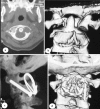One-stage surgical management for tuberculosis of the upper cervical spine by posterior debridement, short-segment fusion, and posterior instrumentation in children
- PMID: 23085858
- PMCID: PMC3540302
- DOI: 10.1007/s00586-012-2544-0
One-stage surgical management for tuberculosis of the upper cervical spine by posterior debridement, short-segment fusion, and posterior instrumentation in children
Abstract
Purpose: To evaluate the clinical study efficacy and feasibility of 11 children with tuberculosis of the upper cervical spine treated by one-stage posterior debridement, short-segment fusion, and posterior instrumentation.
Methods: Eleven children who suffered from tuberculosis of the upper cervical spine were admitted to our hospital between June 2005 and December 2010. All of them were treated by one-stage posterior debridement, short-segment fusion, and posterior instrumentation. Then, the clinical efficacy was evaluated using statistical analysis based on the materials about the visual analogue scale (VAS) scores of pain, JOA scores of nerve function and erythrocyte sedimentation rate (ESR), which were collected at certain time.
Results: The average follow-up period was 28.1 ± 10.5 months (13-42 months). In the 11 cases, no postoperative complications related to instrumentation occurred and neurologic function was improved in various degrees. The average pretreatment ESR was 58.4 ± 4.9 mm/h (53-69 mm/h), which got normal (8.9 ± 6.5 mm/h) within 3 months in all patients. The average preoperative VAS was 7.4 ± 2.2, which decreased to 1.6 ± 1.8 postoperatively. Mean preoperative JOA was 11.2 ± 3.8, and the JOA at the last visit was 16.3 ± 1.0. All patients got bony fusion within 3-8 months after surgery.
Conclusions: One-stage posterior debridement, short-segment fusion, and posterior instrumentation can be an effective treatment method for the treatment of tuberculosis of the upper cervical spine in children.
Figures


Similar articles
-
Halo traction, single-segment circumferential fixation treating cervical tubercular spondylitis with kyphosis.Clin Neurol Neurosurg. 2015 Nov;138:59-65. doi: 10.1016/j.clineuro.2015.08.001. Epub 2015 Aug 5. Clin Neurol Neurosurg. 2015. PMID: 26280284
-
Surgical management by one-stage posterior transforaminal lumbar debridement, interbody fusion, and posterior instrumentation for lumbo-sacral tuberculosis in the aged.Arch Orthop Trauma Surg. 2012 Dec;132(12):1677-83. doi: 10.1007/s00402-012-1604-6. Epub 2012 Aug 30. Arch Orthop Trauma Surg. 2012. PMID: 22933051
-
Anterior debridement, decompression, bone grafting, and instrumentation for lower cervical spine tuberculosis.Spine J. 2014 Apr;14(4):619-27. doi: 10.1016/j.spinee.2013.06.076. Epub 2013 Dec 4. Spine J. 2014. PMID: 24314763
-
One-stage posterior focus debridement, fusion, and instrumentation in the surgical treatment of lumbar spinal tuberculosis with kyphosis in children.Childs Nerv Syst. 2016 Mar;32(3):535-9. doi: 10.1007/s00381-015-2948-3. Epub 2015 Nov 2. Childs Nerv Syst. 2016. PMID: 26527476
-
Treatment for tuberculosis of the subaxial cervical spine: a systematic review.Arch Orthop Trauma Surg. 2021 Nov;141(11):1863-1876. doi: 10.1007/s00402-020-03572-7. Epub 2020 Aug 9. Arch Orthop Trauma Surg. 2021. PMID: 32776174
Cited by
-
Is duration of preoperative anti-tuberculosis treatment a risk factor for postoperative relapse or non-healing of spinal tuberculosis?Eur Spine J. 2016 Dec;25(12):3875-3883. doi: 10.1007/s00586-016-4496-2. Epub 2016 Mar 7. Eur Spine J. 2016. PMID: 26951176
-
360-degree cervical spinal arthrodesis for treatment of pediatric cervical spinal tuberculosis with kyphosis.BMC Musculoskelet Disord. 2016 Apr 23;17:175. doi: 10.1186/s12891-016-1034-7. BMC Musculoskelet Disord. 2016. PMID: 27108221 Free PMC article.
-
Endoscopy-assisted anterior cervical debridement combined with posterior fixation and fusion for the treatment of upper cervical spine tuberculosis: a retrospective feasibility study.BMC Musculoskelet Disord. 2022 Feb 8;23(1):126. doi: 10.1186/s12891-022-05084-4. BMC Musculoskelet Disord. 2022. PMID: 35135516 Free PMC article.
-
Evaluation of clinical outcomes of one-stage anterior and posterior surgical treatment for atlantoaxial tuberculosis complicated with neurological damage.BMC Musculoskelet Disord. 2019 Apr 6;20(1):148. doi: 10.1186/s12891-019-2539-7. BMC Musculoskelet Disord. 2019. PMID: 30954072 Free PMC article.
-
Trends in Spinal Surgery for Pott's Disease (2000-2016): An Overview and Bibliometric Study.Global Spine J. 2017 Dec;7(8):821-828. doi: 10.1177/2192568217735827. Epub 2017 Oct 24. Global Spine J. 2017. PMID: 29238648 Free PMC article.
References
-
- Pandya SK. Tuberculous atlanto-axial dislocation. Neurol India. 1971;19:116–121. - PubMed
-
- Dituno J. Rehabilitation assessment and management in the acute spinal cord injury (SCI) patient. In: Narayan RK, Wilberger JE, Povlishock JT, editors. Neurotrauma. New York: McGraw-Hill; 1996. pp. 1259–1266.
-
- Magerl F, Seeman PS. Stable posterior fusion of the atlas and axis by transarticular screw fixation. In: Kehr P, Weidner A, editors. Cervical spine [M] 4. New York: Springer; 1985. pp. 322–327.
Publication types
MeSH terms
LinkOut - more resources
Full Text Sources
Medical
Research Materials
Miscellaneous

